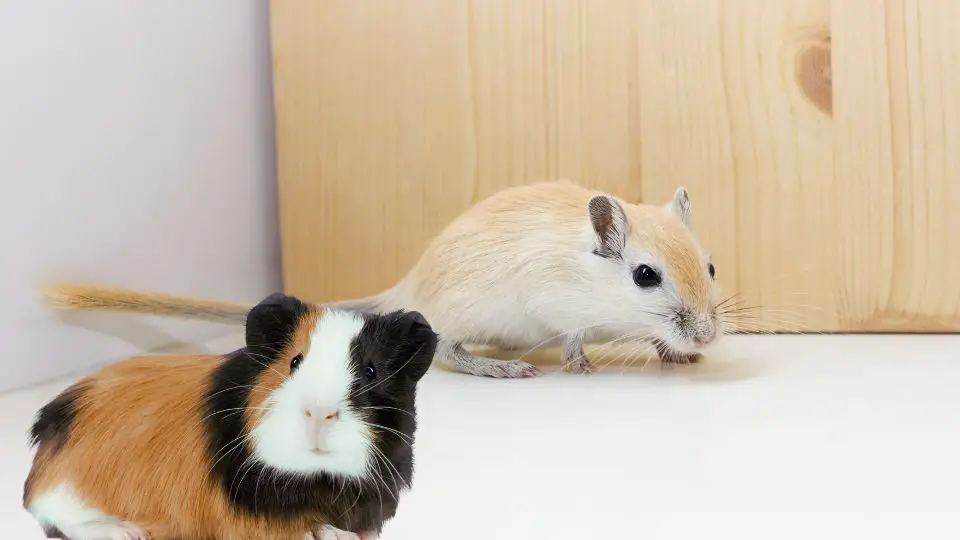Choosing the right location for your gerbil’s cage is crucial for their well-being and happiness.
The placement of the cage affects factors such as temperature, visibility, safety, and accessibility. By selecting an optimal spot, you can provide a comfortable and stimulating environment for your gerbil.
Let’s explore the considerations and tips for finding the best place to put a gerbil cage.
Choose the Right Room
Choosing the right room for your gerbil’s cage is an important decision that can greatly impact their overall well-being and comfort. Gerbils thrive in environments that provide them with a sense of security, peace, and stability.
Here are some considerations when selecting the perfect room for your gerbil companions:
- Quiet Environment: Gerbils are sensitive to loud noises and sudden disturbances. Choose a room that is relatively quiet and free from constant noise or high activity. This will help minimize stress and create a calm atmosphere for your gerbils to feel safe and secure.
- Moderate Temperatures: Gerbils are most comfortable in temperatures between 65-75°F (18-24°C). Avoid rooms that experience extreme temperature fluctuations, such as those near heating vents, air conditioners, or windows that receive direct sunlight. Maintaining a consistent and moderate temperature will help keep your gerbils healthy and content.
- Low Humidity: Gerbils are prone to respiratory issues, and high humidity levels can exacerbate these problems. Choose a room with low humidity to provide an optimal environment for your gerbils’ respiratory health. Avoid placing the cage in areas with excessive moisture, such as bathrooms or damp basements.
Avoiding certain noises near their cage can help reduce stress and promote their well-being. Here are some noises to avoid:
- Loud Music: Gerbils have sensitive hearing, and loud music can startle and stress them. Keep the volume at a moderate level or play soft, soothing music instead.
- Shouting or Screaming: Sudden loud noises like shouting or screaming can frighten gerbils. Keep the area around their cage quiet and avoid raising your voice near them.
- Noisy Appliances: Avoid placing their cage near loud appliances such as vacuum cleaners, blenders, or washing machines. The vibrations and noise can disturb their peace and cause anxiety.
- Banging or Clanging: Excessive banging or clanging noises can startle gerbils and make them feel unsafe. Be mindful of activities that create loud noises near their cage.
- Continuous Alarm Sounds: Alarms that repeatedly go off can create a stressful environment for gerbils. Try to minimize the use of loud alarms or move their cage away from areas with frequent alarm sounds.
Temperature and Lighting
Creating the right temperature and lighting conditions for your gerbil’s cage is essential for their health and well-being. Gerbils are sensitive to temperature changes and lighting conditions, and maintaining the optimal environment can contribute to their overall comfort. Here are our recommendations regarding temperature and lighting for your gerbil:
Temperature Regulation
Gerbils are most comfortable in temperatures between 65-75°F (18-24°C). You should place the gerbil cage away from direct sunlight, as prolonged exposure to direct sunlight can cause the temperature inside the cage to rise significantly and lead to heat stress.
Additionally, avoid placing the cage in areas with drafts, as cold drafts can lower the temperature and make the gerbil uncomfortable. Regularly monitor the room temperature to ensure it remains within the recommended range.
Lighting Conditions
Gerbils are naturally diurnal creatures, meaning they are most active during daylight hours. While gerbils do not require specific lighting conditions, you should provide a consistent light-dark cycle to mimic their natural environment. Avoid overly bright or dim areas, as extreme lighting conditions can disrupt their natural behavior and sleep patterns.
Maintain a regular light schedule by providing a moderate level of ambient light during the day and ensuring a period of darkness during the night for them to rest.
Covering a gerbil cage at night can mimic natural darkness, promote a better sleep routine, and reduce disturbances from external light and noise. Gerbils are crepuscular animals, and a covered cage can create a dark and quiet environment that signals it’s time to rest. However, individual gerbil preferences should be considered, as some may feel more secure with a covered cage while others may be comfortable without one.
Observing their behavior and adjusting accordingly is key. Overall, providing a serene and conducive sleeping environment is essential for your gerbils’ well-being.
Accessibility and Visibility
When deciding where to place your gerbil’s cage, you have to consider accessibility and visibility. Choosing the right location for their cage can greatly enhance their care, interaction, and overall well-being. Here are some key points to consider regarding accessibility and visibility:
- Easy Access for Care: Select a location that allows for easy access to the gerbil cage for daily care and maintenance. This includes tasks such as cleaning, feeding, and providing fresh water. Placing the cage in an easily accessible spot will make these tasks more convenient and efficient for you, ensuring that you can provide the necessary care without any challenges.
- Comfortable Height: Position the gerbil cage at a comfortable height that allows you to observe and interact with your gerbils without straining. Placing the cage at eye level or slightly higher makes it easier to observe their behaviors, monitor their health, and provide enrichment. It also promotes a better bonding experience with your gerbils as you can interact with them at their level.
- Avoid High-Traffic Areas: Gerbils are sensitive creatures, and excessive noise, movement, or frequent disruptions can cause them stress and anxiety. Avoid placing the gerbil cage in high-traffic areas of your home where there is a lot of foot traffic, loud noises, or other disturbances. Instead, choose a quieter area where they can have a sense of security and feel more relaxed.
- Consider Visibility: While gerbils appreciate a quiet environment, they also enjoy some level of visibility. Placing the cage in an area where they can see and be seen can help prevent feelings of isolation and encourage social interaction. However, be mindful of striking a balance between visibility and providing them with enough privacy and retreat spaces within the cage.
Safety and Security
Keep the gerbil cage away from other pets, such as cats or dogs, that may view the gerbils as prey or pose a potential threat. Even if your other pets are well-behaved and non-aggressive, it’s essential to maintain a safe distance to prevent stress or harm to your gerbils. This will ensure that they can live without fear or anxiety. Here are some points to consider regarding safety and security:
- Avoid Potential Hazards: Assess the area around the gerbil cage and remove any potential hazards that may cause stress or harm to the gerbils. This includes keeping the cage away from sharp objects, toxic plants, electrical cords, or any other items that may pose a risk. Creating a hazard-free zone will provide a secure environment for your gerbils to thrive.
- Secure and Stable Cage: Ensure that the gerbil cage is secure and stable to prevent accidental tipping or escape. Gerbils are known to be excellent climbers and escape artists, so it’s crucial to choose a cage with secure locks and sturdy construction. Regularly check the cage for any loose parts or openings that may allow the gerbils to escape or get injured.
- Consider Gerbil-Proofing: Gerbils are curious creatures and may chew on objects or wires within their reach. Take measures to gerbil-proof the area around the cage by covering or organizing any exposed wires, removing potentially harmful objects, and providing suitable chewing toys or blocks to redirect their chewing behavior.
Environmental Considerations
Avoid placing the gerbil cage near sources of strong odors, chemicals, or smoke. Gerbils have sensitive respiratory systems, and exposure to these irritants can lead to respiratory issues or discomfort. Keep the cage away from areas where strong-smelling substances are used, such as cleaning agents, perfumes, or air fresheners.
Additionally, avoid smoking near the gerbil cage, as second-hand smoke can be harmful to their health.
We must emphasize that gerbils thrive in a calm and peaceful environment. Loud noises, vibrations, or constant disruptions can stress them out and negatively impact their well-being. Choose a location for the gerbil cage that is away from high-traffic areas or noisy household appliances, such as televisions or speakers. Providing a serene atmosphere will help your gerbils feel secure and reduce unnecessary stress.
Social Interaction
Finally, gerbils are social animals that thrive on companionship and interaction. To strengthen the bond with your gerbils and ensure their well-being, we recommend considering the following:
- Cage Placement: Position the gerbil cage in a central area of your home for easy observation and engagement.
- Regular Handling: Handle your gerbils gently and regularly to familiarize them with human touch and build trust.
- Hand-Feeding: Offer treats from your hand to create positive associations and strengthen the bond.
- Playtime and Enrichment: Create a safe play area outside the cage with tunnels, toys, and interactive items for mental and physical stimulation.
- Multi-Gerbil Enclosure: If you have multiple gerbils, ensure they have companionship within their cage.
- Observe Gerbil Behavior: Pay attention to their body language and reactions, respecting their boundaries and preferences.
Do gerbils need time outside cage?
Yes, gerbils benefit from having time outside of their cage to explore and engage in additional activities. While gerbils require a safe and secure enclosure as their primary living space, allowing them supervised playtime outside the cage provides mental stimulation, exercise, and a change of environment. Here is what you should keep in mind about giving your small pet time outside their cage:
- Secure the Area: Create a designated play area that is escape-proof and free from potential hazards. Ensure that the space is enclosed, with no small openings or gaps where gerbils can escape or get stuck.
- Supervision: Always supervise your gerbil during playtime outside the cage to ensure their safety and prevent accidents. Gerbils are fast and curious, so keeping a close eye on them is essential.
- Remove Dangers: Remove any potentially harmful objects or substances from the play area, such as wires, toxic plants, or chemicals. Make sure there are no open doors or windows that could allow the gerbil to escape.
- Provide Enrichment: Place toys, tunnels, and other enrichment items in the play area to encourage exploration and mental stimulation. Gerbils enjoy climbing, digging, and running, so incorporate items that cater to their natural instincts.
- Time and Frequency: The duration and frequency of playtime outside the cage can vary. Start with shorter sessions and gradually increase the time as your gerbil becomes more comfortable. Aim for at least 20-30 minutes of supervised playtime a few times a week.
Wrapping up
Finding the ideal location for your gerbil’s cage is essential for their overall well-being. Consider factors such as temperature, lighting, accessibility, safety, and social interaction when deciding where to place the cage. By creating a suitable environment, you can ensure that your gerbil is comfortable, secure, and able to thrive in their new home.
Remember to regularly monitor the conditions and make adjustments as needed to provide the best possible living environment for your furry friend.







